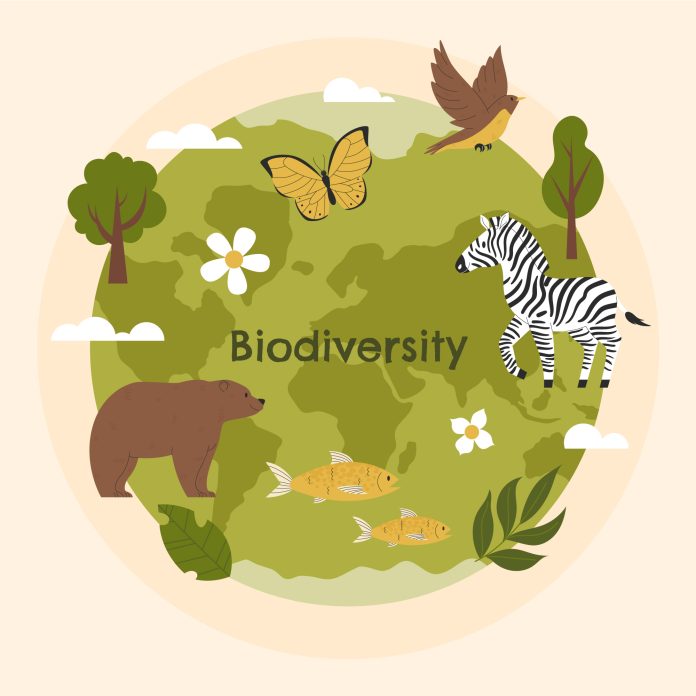Biodiversity is essential for the process that supports all the life on Earth which also includes humans. Without a wide range of animals, plants and microorganisms, we cannot have the healthy ecosystems that we rely on to provide us with the air we breathe and the food we eat. People also value nature.
Some aspects of biodiversity are instinctively widely valued by people but the more we study biodiversity the more we see that all of it is important – even bugs and bacteria that we can’t see or may not like the look of. Pollinators such as birds, bees and other insects are estimated to be responsible for a third of the world’s crop production. Without pollinators, we would not have apples, cherries, blueberries, almonds and many other foods we eat. Agriculture is also reliant upon invertebrates – they help to maintain the health of the soil crops grow in. Soil is teeming with microbes that are vital for liberating nutrients that plants need to grow, which are then also passed to us when we eat them.
Every year, International Day for Biological Diversity (IDB) is observed to promote comprehension and consciousness of biodiversity concerns. This global event, also referred to as World Biodiversity Day, revolves around acknowledging biodiversity’s vital role in supporting our nourishment and well-being, and as a fundamental driver for enhancing food systems and human health.
Tropical regions, areas that are warm year-round, have the most biodiversity. Temperate regions, which have warm summers and cold winters, have less biodiversity. Regions with cold or dry conditions, such as mountaintops and deserts, have even less.
America is the continent that has the most countries rich in biodiversity: Brazil, Colombia, Ecuador, Mexico, Peru, Venezuela and the United States. For its part, in Asia, the countries with the greatest bio-diversity are China, Indonesia, India, Philippines and Malaysia.
Brazil. It is the country with the greatest biodiversity of flora and fauna on the planet. Brazil has the highest number of species of known mammals and freshwater fish, and more than 50,000 species of trees and bushes, it takes first place in plant diversity.
The Significance of Biodiversity:
Ecosystem Vigor: Biodiversity is the bedrock of thriving ecosystems, where every species, no matter its size, contributes to the delicate harmony of these intricate systems. The loss of any species can cause a diverse effect which can unsettle the equilibrium of the entire ecosystem.
Food Security: The bounty of biodiversity is woven into our sustenance. Various array of crops, pollinators, and soil microorganisms protect agricultural areas. Safeguarding biodiversity ensures vibrant resources for food production which enhances the resilience of our food systems.
Medicinal Marvels: Within diverse ecosystems lie the sources of many medicinal wonders. Indigenous communities for a long time have drawn upon the biodiversity around them for traditional medicines, and modern medicine continues to uncover these potential treatments.
Climate Harmony: Biodiverse landscapes, from verdant forests to expansive oceans, play a pivotal role in climate regulation. Trees absorb carbon dioxide, oceans sequester carbon, and diverse ecosystems that contribute to climate resilience.
History of the Biodiversity Day
The origins of the International Day for Biological Diversity can be traced back to the United Nations Conference on Environment and Development, commonly referred to as the Earth Summit, which took place in Rio de Janeiro, Brazil, in 1992.
It was during this momentous gathering that global leaders acknowledged the pressing necessity to confront the worldwide decline of biodiversity. Consequently, on December 29, 1992, a substantial number of nations adopted the Convention on Biological Diversity (CBD).
Conservation Initiatives:
Convention on Biological Diversity (CBD): The CBD, a global treaty adopted at the Earth Summit in 1992, aims to conserve biological diversity, promote sustainable use of its components, and ensure fair and equitable sharing of benefits arising from genetic resources. Various countries have committed to the CBD’s goals which will foster international cooperation in biodiversity conservation.
National Biodiversity Authority (NBA): Established in 2003, the NBA focuses on regulating access to biological resources and associated traditional knowledge.
Integrated Development of Wildlife Habitats (IDWH): Launched by the Ministry of Environment, Forest and Climate Change, IDWH supports the conservation of wildlife and its habitats.
Green India Mission (GIM): As part of the National Action Plan on Climate Change, GIM focuses on afforestation, biodiversity conservation, and enhancing ecosystem services.
National Mission on Himalayan Studies (NMHS): It was launched with the aim of the conservation of the Himalayan ecosystem, NMHS aims to undertake research, monitoring, and capacity building.
National Mission for Sustainable Agriculture (NMSA): NMSA works towards promoting sustainable agriculture practices that contribute to biodiversity conservation.
National Afforestation Programme (NAP): NAP, launched by the Ministry of Environment, Forest and Climate Change, focuses on afforestation and reforestation activities. By restoring degraded ecosystems and promoting sustainable forestry practices, NAP largely contributes to biodiversity conservation
International Day for Biological Diversity is a reminder of the pressing need to take action and protect biodiversity to ensure the long-term survival of ecosystems and species. Biodiversity is vital for sustainable development. It plays a crucial role in providing ecosystem services such as clean air and water, pollination, soil fertility, and climate regulation. This day emphasises the link between biodiversity conservation and achieving the Sustainable Development Goals.































